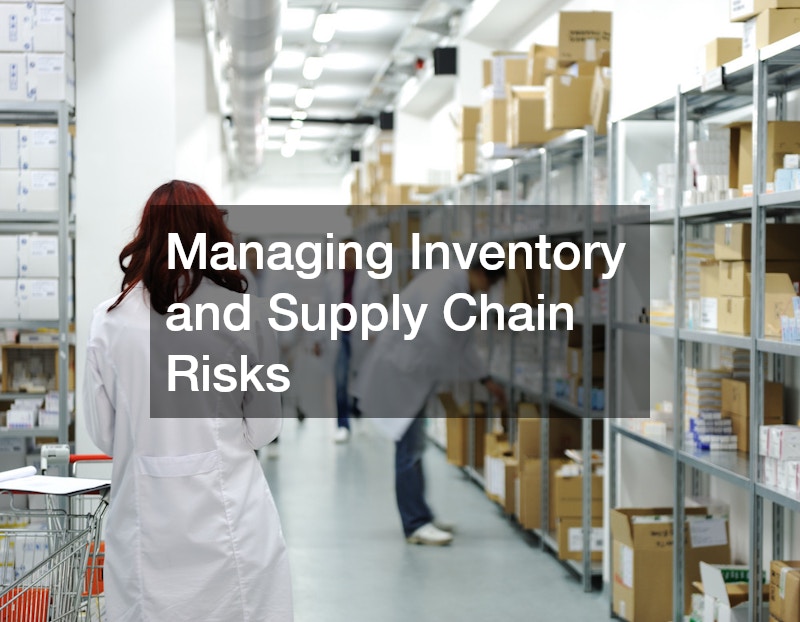In today’s fast-paced business world, risks are a natural part of any operation. Whether you’re running a small startup or managing a large corporation, understanding, managing, and mitigating risks through effective risk management strategies is critical for long-term success. A business that fails to address its operational risks and safety concerns is more likely to face legal liabilities, financial losses, and operational disruptions. However, by identifying the key risks in your industry and implementing proper risk management strategies, you can protect your business, employees, and customers, while also ensuring continuous growth.
This article will explore how businesses can manage risks and improve safety across various industries, offering actionable advice to help entrepreneurs make informed decisions in their operations.
- Introduction
- Mitigating Financial Risks and Legal Challenges
- Minimizing Construction-Related Risks
- Safeguarding Worker Health and Preventing Liability
- Managing Inventory and Supply Chain Risks
- Enhancing Delivery Security and Efficiency
- Reducing Cybersecurity Risks and Service Downtime
- Preventing Equipment Failures and Enhancing Operator Safety
- Reducing Risk in Fleet Management and Vehicle Coverage
- Managing Liability and Ensuring Customer Safety
- Ensuring Employee Health and Legal Compliance
Introduction
Risk management strategies and safety measures are not just about preventing accidents and legal issues; they are also about ensuring efficiency, building trust, and protecting the long-term viability of your business. Companies that actively manage risks are more likely to improve their operational efficiency, meet regulatory requirements, and maintain customer satisfaction.
The first step to managing risks is conducting a thorough risk assessment. This involves evaluating every area of your business, identifying vulnerabilities, and prioritizing the risks that could potentially cause the most harm. Once these risks are identified, businesses can take steps to mitigate them through the implementation of preventive measures, insurance policies, and contingency plans.
Mitigating Financial Risks and Legal Challenges

Repossession companies face numerous challenges that require a strategic approach to mitigate risks and ensure smooth operations. These challenges are often multifaceted, involving financial risks, property damage, legal disputes, and employee safety concerns. The core responsibility of a repossession company is to reclaim assets from individuals or businesses that have defaulted on loans, which can be a delicate process. If not handled properly, repossession efforts can lead to legal consequences, property damage, and even harm to employees. As such, repossession companies must adopt practices that balance efficiency with legal and safety considerations.
One of the primary ways a repossession company can protect itself is by securing comprehensive insurance coverage. Insurance policies that cover potential liabilities such as property damage and legal disputes are critical for safeguarding the business against the financial fallout from lawsuits. In the event of damage to the property being repossessed or a legal dispute arising from the repossession process, having robust insurance coverage ensures that the repossession company will not bear the full financial burden. This not only provides peace of mind but also supports the company’s long-term financial stability.
Another essential component of running a successful repossession company is proper legal training for employees. Repossession agents must be thoroughly educated about local laws, the rights of individuals whose property is being reclaimed, and the procedures that need to be followed during the repossession process. In many cases, improper repossession practices can lead to costly lawsuits, damage to the company’s reputation, and even regulatory fines. Ensuring that employees understand the legal boundaries and obligations involved in repossession reduces the risk of legal action and helps maintain a professional and compliant operation within the repossession company.
Minimizing Construction-Related Risks
Design-build companies, which are responsible for both the design and construction phases of a project, face a variety of risks that can impact their ability to deliver successful outcomes. Managing these risks is critical for maintaining smooth operations, meeting client expectations, and ensuring the overall success of a project. These risks include project delays, safety hazards, and the potential for design errors, all of which can have significant financial and reputational consequences if not addressed effectively. Given the complexity of handling both design and construction, design-build companies must implement robust strategies to mitigate these risks and maintain a high standard of quality throughout the project lifecycle.
One of the most effective ways to manage risks in a design build company is through the use of project management tools. Project management software is invaluable for tracking project timelines, budgets, and overall progress. This software allows team members to stay on the same page by providing real-time updates on the status of various tasks and milestones. By using these tools, a design-build company can identify potential delays, budget overruns, or resource shortages early in the process, which allows for quicker resolution and helps keep the project on track. This proactive approach not only minimizes the risk of project delays but also fosters better communication and collaboration among team members and stakeholders, ensuring that expectations are consistently met.
Safety is another crucial concern for design-build companies, especially since the construction industry is known for its higher rates of workplace accidents. Developing a safety-first culture within the company is essential to preventing injuries and maintaining a productive work environment. Regular safety training for all workers is a critical component of this approach, ensuring that employees are familiar with the latest safety protocols and are equipped to handle potential hazards on the job site. By making safety a top priority, a design-build company can reduce the risk of accidents, avoid costly workers’ compensation claims, and create a reputation for being a responsible and reliable contractor.
Safeguarding Worker Health and Preventing Liability
Commercial roofing services face substantial risks due to the inherently dangerous nature of their work. Roofers in this field are frequently exposed to hazardous conditions such as working at heights, extreme weather, and the use of heavy equipment, all of which increase the likelihood of accidents and injuries. In addition to these physical risks, commercial roofing services must also manage the liability associated with faulty repairs and poor workmanship. If a roofing job is done improperly, it can lead to significant property damage or costly repair claims, further complicating the company’s risk management efforts. As a result, safety and quality control are paramount to the long-term success and reputation of any commercial roofing service.
One of the most critical safety measures commercial roofing services can invest in is fall protection systems. Since falls from heights are the leading cause of injury in roofing, implementing fall protection measures such as guardrails, safety nets, and personal fall arrest systems is vital. These systems are not only essential for protecting workers but are also required by the Occupational Safety and Health Administration (OSHA) regulations. OSHA mandates that fall protection must be provided when working at elevations of six feet in the construction industry, including commercial roofing. By adhering to these standards, commercial roofing services can significantly reduce the risk of falls and avoid fines for non-compliance. Investing in these protective measures demonstrates the company’s commitment to worker safety and helps prevent accidents that could lead to injury or even fatalities.
Managing Inventory and Supply Chain Risks

Public bonded warehousing plays a critical role in storing goods on behalf of businesses, particularly for items awaiting customs clearance or further distribution. However, managing these warehouses comes with inherent risks, such as inventory management challenges, theft, damage, and adherence to customs regulations. Ensuring the security of stored goods and complying with regulatory requirements are essential aspects of managing risk in the public bonded warehousing industry.
One of the primary risks in public bonded warehousing is inventory control. Improper tracking or organization of goods can lead to misplaced or lost inventory, which could disrupt the supply chain and harm business operations. Additionally, theft remains a significant concern for public bonded warehouses, as they often store high-value goods. To protect against theft and unauthorized access, investing in state-of-the-art security systems such as CCTV surveillance, motion sensors, and alarm systems is crucial. Regular monitoring of these systems ensures that goods are safe and secure while providing real-time alerts in case of any suspicious activity.
Staff training is another vital component in reducing risks in public bonded warehousing. Employees must be well-trained in both inventory management and the specific regulations that govern bonded warehouses. This ensures that goods are handled properly, reducing the chances of errors or non-compliance with customs and regulatory requirements. Properly trained staff can also spot potential security risks before they become problems, further reducing the risk of theft or damage.
Enhancing Delivery Security and Efficiency

In the logistics industry, package theft, loss, and delays pose significant risks that can harm a company’s reputation and financial performance. To mitigate these risks, many logistics companies have turned to GPS package tracking devices as a critical tool in enhancing both security and operational efficiency. The integration of these devices has become an essential strategy for businesses looking to improve their delivery processes, ensuring that packages reach their destinations on time and in good condition.
Real-time tracking through GPS package tracking devices allows companies to monitor the exact location of packages at every stage of the delivery process. This capability helps prevent theft, as packages can be traced if they go missing, allowing for an immediate response. Additionally, it enables businesses to track delays and take swift corrective actions, ensuring that customers are kept informed and that packages are delivered without unnecessary setbacks. The ability to monitor deliveries in real-time not only enhances security but also boosts operational efficiency.
Customer transparency is another key advantage of GPS package tracking devices. By providing customers with access to real-time tracking information and updates throughout the delivery process, companies can improve customer satisfaction and build trust in their brand. Customers appreciate knowing exactly where their packages are and when they can expect delivery, which fosters a sense of reliability and confidence in the company’s services. This transparency also reduces customer inquiries and complaints, contributing to a smoother customer experience.
Furthermore, GPS package tracking devices support delivery optimization. Logistics companies can use the data provided by these devices to implement route optimization software, which determines the most efficient delivery routes based on real-time traffic conditions and package locations. This optimization reduces delivery times, lowers fuel consumption, and minimizes the risk of delays, ultimately enhancing the cost-effectiveness of the entire delivery process. By reducing unnecessary detours and fuel waste, companies can streamline their operations and improve profitability.
Reducing Cybersecurity Risks and Service Downtime
For IT service providers, managing cybersecurity risks is crucial to maintaining the integrity of operations and safeguarding both company and client data. Cyberattacks, data breaches, and service downtime can severely damage a company’s reputation, erode customer trust, and lead to substantial financial losses. Given the increasing frequency and sophistication of cyber threats, it is essential for an IT services provider to adopt a proactive approach to cybersecurity to minimize these risks and protect their operations.
One of the most effective ways to defend against cyber threats is through the implementation of robust cybersecurity measures. Multi-layered security protocols such as firewalls, encryption, and two-factor authentication provide a strong defense against data breaches and cyberattacks. Firewalls act as a barrier to unauthorized access, while encryption ensures that sensitive data remains unreadable to attackers. Two-factor authentication adds an additional layer of security, ensuring that only authorized individuals can access critical systems and information. By combining these technologies, IT service providers can create a more secure environment for both their business operations and their clients’ data.
In addition to strong cybersecurity measures, backup systems play a vital role in mitigating the risks of data loss and downtime. Regularly backing up client data and system configurations ensures that in the event of an attack, businesses can quickly recover and restore their systems to normal. Automated backup solutions can streamline this process, ensuring that backups are conducted frequently and with minimal human intervention. This not only saves time but also reduces the risk of losing critical data that could disrupt operations and cause further financial setbacks.
Preventing Equipment Failures and Enhancing Operator Safety
CNC (Computer Numerical Control) machines are widely used in manufacturing for their ability to produce high-precision parts and components. While these machines enhance productivity and accuracy, they also introduce a range of risks, including mechanical failure, operator injury, and production downtime. Proper risk management is essential to ensure that CNC operations remain efficient, safe, and profitable.
Regular maintenance is one of the most effective strategies to minimize the risk of machine breakdowns and costly repairs. Implementing a routine preventive maintenance schedule for a CNC machine allows operators to detect potential issues before they lead to more significant problems. Regular inspections can identify worn-out components, misalignments, or lubrication deficiencies, all of which can contribute to machine failure if left unchecked. By addressing these issues proactively, businesses can avoid unplanned downtime, reduce repair costs, and ensure that machines remain in optimal working condition for longer periods.
Safety protocols are also critical in reducing the risks of operator injury. CNC machines can be dangerous if not handled properly, with moving parts, sharp tools, and high-speed operations posing various hazards. Ensuring that operators are well-trained in the proper use and safety procedures is essential for reducing accidents. Operators should be familiar with the machine’s controls, emergency stop functions, and safe operating practices. Providing personal protective equipment (PPE), such as safety glasses, gloves, and ear protection, can also help mitigate the risk of injury from flying debris, noise, or other potential dangers in the workplace. Creating a safety-conscious environment and fostering a culture of awareness can go a long way in preventing accidents.
Reducing Risk in Fleet Management and Vehicle Coverage
Businesses with fleets of vehicles face several risks that can impact both operations and finances, including accidents, theft, and damage to company vehicles. These risks can be minimized through proper risk management strategies, particularly with a comprehensive automotive insurance plan. A solid insurance policy tailored to the needs of the fleet is essential for protecting the business, ensuring vehicles are covered against damage, and mitigating the financial consequences of accidents and theft.
Comprehensive insurance coverage is critical for any fleet management strategy. A well-rounded policy should cover both vehicle damage and third-party liability, providing protection in the event of accidents, vehicle theft, or even legal claims. This type of coverage ensures that the company is financially protected against the costs associated with repair or replacement of damaged vehicles, as well as the potential liabilities resulting from accidents involving third parties. Businesses should carefully review their insurance plan to make sure it includes coverage for a wide range of risks, from physical damage to vehicles to legal costs arising from collisions or other incidents.
Managing Liability and Ensuring Customer Safety
Auto repair services face significant liability risks, especially related to faulty repairs, customer dissatisfaction, and injuries sustained by employees while on the job. To minimize these risks and maintain a positive reputation, auto repair businesses must implement strong safety practices and customer satisfaction protocols. These proactive measures not only help reduce legal and financial liabilities but also improve overall operational efficiency and customer trust, ensuring long-term success.
One of the most effective ways to mitigate liability risks in auto repair services is by offering clear, comprehensive service warranties. A well-structured warranty provides customers with peace of mind, assuring them that any issues resulting from repairs will be addressed at no additional cost. This not only boosts customer confidence but also protects the business from potential legal claims stemming from faulty services or dissatisfaction. By offering warranties that clearly define the scope of coverage, auto repair services can prevent misunderstandings and disputes, reducing the likelihood of costly legal issues. Additionally, a solid warranty program can enhance the shop’s reputation for reliability and customer service, encouraging repeat business and positive referrals.
Ensuring Employee Health and Legal Compliance
Workers’ compensation is a vital aspect of any business operation, ensuring that employees are financially protected in the event of a workplace injury. Not only is it essential for avoiding costly legal disputes, but it also helps businesses comply with state regulations and demonstrates a commitment to the health and safety of employees. Ensuring that your workers are covered by the appropriate workers’ compensation insurance is crucial for the long-term success of your business.
One of the first steps in managing workers’ compensation effectively is ensuring that your business complies with insurance requirements. The level of coverage required typically depends on the number of employees and the specific risks associated with your industry. Most states mandate workers’ compensation insurance, and failure to comply can result in severe penalties, fines, or lawsuits. Workers comp protects both employees and employers, covering medical expenses, lost wages, and legal claims resulting from workplace injuries. Ensuring that your business has the correct coverage in place can help safeguard your employees and protect your company from financial strain in the event of an injury.
Implementing effective safety measures is another key aspect of workers’ compensation risk management. A comprehensive safety program can significantly reduce the likelihood of workplace injuries, helping to maintain a healthier and more productive work environment. This includes conducting regular safety audits, installing proper signage, and ensuring that employees are well-trained in safe work practices. Providing safety gear, encouraging regular breaks, and fostering a safety-conscious culture all contribute to reducing the risk of accidents. By prioritizing safety and minimizing hazards, businesses can lower their workers’ compensation claims and overall costs.
Effective risk management is not a one-time task but an ongoing process. Regularly reviewing your risk management strategies, keeping up with industry regulations, and investing in training and technology are key steps to mitigating risks in your business operations. Ultimately, businesses that invest in safety measures, proactively manage risks, and stay compliant with regulations are more likely to experience continued growth and success. Managing risks should be seen as an investment in the longevity and stability of your company.


